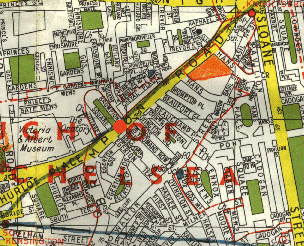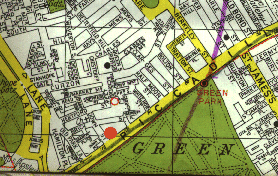 Abandoned
Stations of the Underground
Abandoned
Stations of the Underground
![]() 31st
May 2003. Most written in 1996.
31st
May 2003. Most written in 1996.
Most of this document was written as result of a stay in London when I was a teenager. I was lucky enough to be staying in a house with a LU train driver who took me on a number of rides in the cab of several Metro-Camels and then on the Yerkes Tube trains which were lower.
![]() There
are several abandoned or disused railway stations on the London Underground
system. While staying in London many years ago I spent a week camping out at
Brompton Road underground station (with permission) of the club up there. Most
abandoned London Underground stations have now been boarded up and are not easily
noticeable when you pass them unless you know they are there. Most exploration
of these stations was superficial, consisting of peering out of train windows
as I went past many times.
There
are several abandoned or disused railway stations on the London Underground
system. While staying in London many years ago I spent a week camping out at
Brompton Road underground station (with permission) of the club up there. Most
abandoned London Underground stations have now been boarded up and are not easily
noticeable when you pass them unless you know they are there. Most exploration
of these stations was superficial, consisting of peering out of train windows
as I went past many times.
The best line to observe abandoned underground railway stations from is the Picadilly line which has no less than five abandoned stations, the first three of which are underground. These are Brompton Road, Down Street, York Road, Osterley & Spring Grove and Hillingdon Swakeleys, the latter two above ground.
Stations I have explored:
Brompton Road

Map showing the location of Brompton Road station. The orange shape is Harrods.
This station is located on Brompton Road in Kengsington, not far from Harrods between Knightsbridge station and South Kengsington. It is unknown why the station was closed. Though it is likely that with the close location of Knightsbridge station and the closer South Kengsington, there was a lesser need for the station. Also, Knightsbridge had an entrance to Harrods built into it. The platforms (2 of them), stairways and ticket hall are all intact although almost all fittings are closed and the above ground section has been converted into a pistol club. The station was closed in 1934 and not used since.
Although most of the fittings have been removed there were toilets still serviceable in 1990, although they did require a bit of cleaning. The station has obviously seen a number of temporary inhabitants over the years, showing signs of people sleeping there. In 1993 police sealed the station from above ground access due to the discovery of a dead body there.
![]() 26th
January 2003. I have been able to find out that the body was that of
a student from the military college above. According to what I have been able
to find out the body was found at the bottom of a ventilation shaft. I would
presume that a young adventurer had decided to break into the ventilation shaft,
and had fallen the 110 Ft to the bottom of the tunnel. A train driver at the
scene reported that the body had quite shiny shoes, and was well dressed even
though it had been there for at least three months before it was found. You
can read more about it and see photos here: http://www.subbrit.org.uk/rsg/sites/b/brompton_road/
26th
January 2003. I have been able to find out that the body was that of
a student from the military college above. According to what I have been able
to find out the body was found at the bottom of a ventilation shaft. I would
presume that a young adventurer had decided to break into the ventilation shaft,
and had fallen the 110 Ft to the bottom of the tunnel. A train driver at the
scene reported that the body had quite shiny shoes, and was well dressed even
though it had been there for at least three months before it was found. You
can read more about it and see photos here: http://www.subbrit.org.uk/rsg/sites/b/brompton_road/
It was the staff of the college who surreptitiously had given me permission to look at the station in the first place. Mind you, I don't think they really should have.
![]()
Down Street

Down Street Station, located on the edge of Green Park
Of all the abandoned tube stations on the London Underground Down Street is by far the most interesting in terms of it's history. Down street closed in 1932 because neighboring stations were fitted with escalators and Down Street was not. It is located between Green Park and Hyde Park Corner stations. During World War II, the closed station at Down Street was converted into the headquarters of the Railway Executive - the body that controlled all railways during and immediately after the war. Walls were built along the platform edges, and the resulting space was converted to offices. Access was normally from the surface, but trains could also be stopped to allow people in and out of the driver's cab. There was a small platform to allow access from the driver's cab.
In 1990 Down street was easy to miss as the boarded up center platforms are so covered with dirt and dust that they resembled the sides of the tunnel. There is minimal space between these walls and the sides of trains although the alcove where people could get in and out of the driver's cab still exists and from here it is possible to enter the office complex between the platforms. At the time I visited the area it was being used as a storage and maintenance area with little sign of any LU employees having accessed it recently. There were some people occupying the old offices though, having set up camp in them. The station had running water available, apparently the mains had been switched off but a bypass had been worked in.
Access to above ground was available at this station but apparently seldom used. Many of the people living in the station mentioned that they slept there during winter but preferred sleeping in Green Park when the weather permitted. I have since heard that this station is no longer used by homeless people.
![]()
British Museum

British Museum and the landmark from which it gains its' name.
This station was closed in 1933. It is located on the Central Line, between Holbourn and Tottenham Court. Like Brompton Road and Down street this station features a center platform. The ticket halls are still semi intact, although a lot of wire mesh fences restrict access to the areas. Above ground access is not possible without some work in removing wood panels and brick work. The above ground section of this station is in use as shop as of 1990 and when I visited it was not recognizable as a former station.
![]()
Stations I have briefly visited:
White City.
Many Londoners would be familiar with the currently open White City station on the Central Line. Many would have also seen the small abandoned platform of the older White City station that is visible before reaching the newer above ground White City Station. This is probably one of the best abandoned London Underground stations as you can actually see a bit. During the daytime it is possible to see light in the exit stairwell (I think that's what it is) and make out a platform on the northern side of the track, normally the inbound track. I did not visit the above ground area of this station although I was tempted to get off and explore. I never seemed to have enough time.
![]()
Mark Lane
This station was closed relatively recently, in 1967. It features two separate outer platforms, which at times still featured lighting and advertising. I did not visit this station but traveled though it several times on the way to Tower Hill. The above ground section of the station has been turned into a shop. In 1990 it was a grocery shop. Mark Lane is located between Tower Hill and Monument on the Circle Line
![]()
Other Abandoned Stations:
Lords and Marlborough Road
These former stations are located at Lord's Cricket Ground in north west London, not far from the Grand Union Canal and Marlborough Road. Both stations were closed in 1939 in part of the streamlining of the Metropolitan line and later the Jubilee line. I don't know much about these stations, not being aware of their existence in 1990 when I last visited London. Both are underground sub surface stations.
![]()
York Street
I know little about this station other than it was located north of King's Cross - St Pancras, between that station and Caledonian Road. I have since been told it was located on York Way. It was also closed in 1932, four months after Down Street.
![]()
King William Street
This is a very interesting station as it is not actually part of the operating network of the London Underground anymore, no trains run through it. I was told by station staff back in 1984 that part of this former station now serves as the pedestrian tunnel between Monument station and Bank station. However, I have now been updated on this. It seems that from various sources, most of them being rail fans, and therefore unreliable at best, that King William Street station is located near Monument station. Not one of these so called 'experts' was able to tell me exactly where, but they've insisted that King William Street Station was never part of Monument and Bank.
![]()
Bull and Bush
This station was never opened, the only never opened station that I am aware of on the London Underground. It is located on the Northern Line in the tunnel on the Edgware branch between Hampstead and the end of the tube. This station was never opened to the public. It appears that the station was never fitted out or that all fittings were removed and the station was subsequently boarded over and fitted with various Department of Defence instillations.
![]()
City Road
Located on City Road in north east road of London on the City Line. The station is located between Old Street and The Angel. The station was one of the earliest closed in the London Underground network, being closed in 1922. Like most stations on the LU, the station features a central platform. I believe there is surface access in the form of a small building and a vent grille.
![]()
Others:
Ongar and North Weald were abandoned in 1994, Blake Hall closed in 1981 but I have no further details about them. Each was an above ground station with a single platform each. Rumours abound that they may one day be put back into service.
At Chancery Lane there is a deep Shelter tunnel, possibly still accessible if you have a key to the door. It is now used for documents storage.
![]()
|
Best
Viewed at
|
||
| About this site |
|
©Copyright
notice
© This entire site is copyrighted 1997 - 2006. No image or text may be reproduced, edited, copied, stored in any off-line storage device, or placed on any another website at any time, without written permission from Panic!, web site owner. |